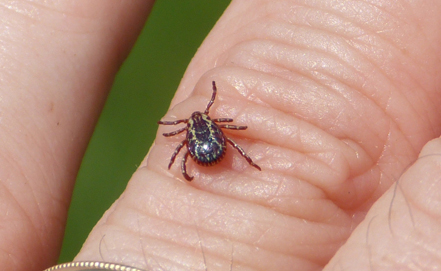While enjoying activities outside, don’t forget to take action to prevent bites from ticks that share our outdoor spaces. Ticks can infect humans and wildlife with bacteria, viruses and parasites that can cause serious illness.
There are two species of ticks in Lake County: deer tick (Ixodese scapularis) and wood tick (Dermacentor variabilis). Of these two species, only deer ticks can pass on Lyme disease. However, wood ticks, also referred to as American dog ticks, do have the ability to pass on other bacterial infections such as Rocky Mountain spotted fever and tularemia.
Wood Tick

-
Unlikely to transmit Lyme disease
-
Twice as large as a deer tick
-
Dark body with white markings near head (female)
-
Dark body with white markings covering back (male)
-
Found most commonly in grassy and shrubby areas
-
Also referred to as American dog tick
-
Can transmit bacterial infections, such as Rocky Mountain spotted fever and tularemia
Deer Tick

-
Can transmit Lyme disease
-
Very small in size
-
Brownish-orange with black spot near head (female)
-
All back with then brown border on rear edge (male)
-
Found most commonly in wooded areas and leaf litter
-
Also referred to as black-legged tick
-
Can transmit other pathogens, such as Babesia and Anaplasma
Before You Go Outdoors
-
Choose light-colored, long sleeve clothing
-
Tuck long pants into socks
-
Apply insect repellent with DEET to your clothing (avoid your skin)
-
Products with permethrin can kill ticks; used to treat boots, clothing and gear for extended protection
During Outdoor Activities
-
Know where to expect ticks; most commonly found in wooded areas and tall grasses
-
Stay in center of trails when hiking; ticks wait on vegetation and grasp onto anything that passes
-
Keep lawns and grass around play equipment trimmed short
After You Come Indoors
-
Check your clothing and pets thoroughly
-
Remove ticks found on your clothing or pets and dispose of them
-
Place clothing in a dryer on high heat for one hour to kill ticks and prevent them from dropping off in your home to search for a host
-
Check your body thoroughly for ticks
-
Shower soon after coming inside; this provides the best view (also helps prevent poison ivy reactions)
If You Find a Tick Embedded in Your Skin
Follow suggestions above to find ticks on your body before they bite. If a tick is overlooked and is later found attached to the body:
-
Remove it immediately using small tweezers
-
Grasp the mouth parts, as close to your skin as possible
-
Pull it straight out slowly and avoid squeezing its body
-
Wash the wound site and your hands thoroughly
-
Visit a physician if unexplained rash or illness accompanied by fever develops